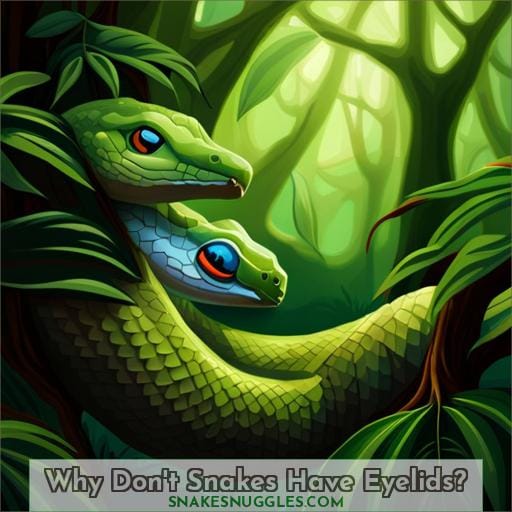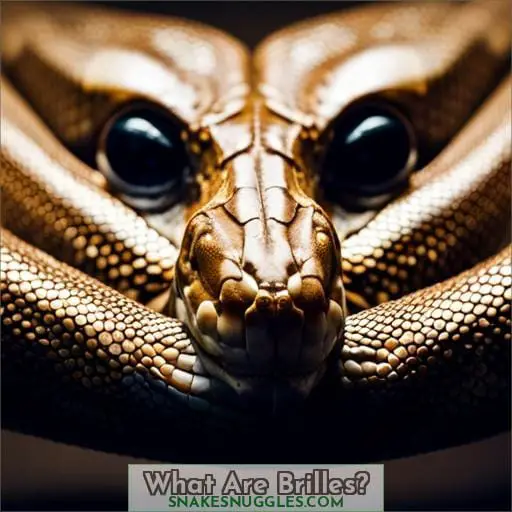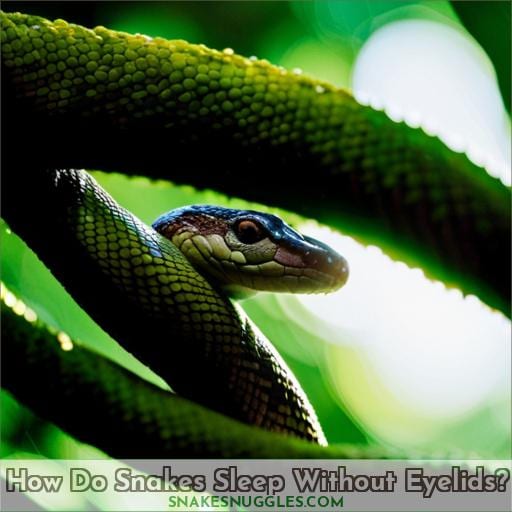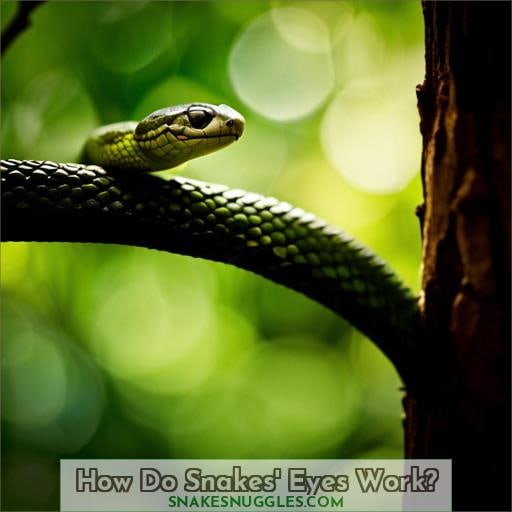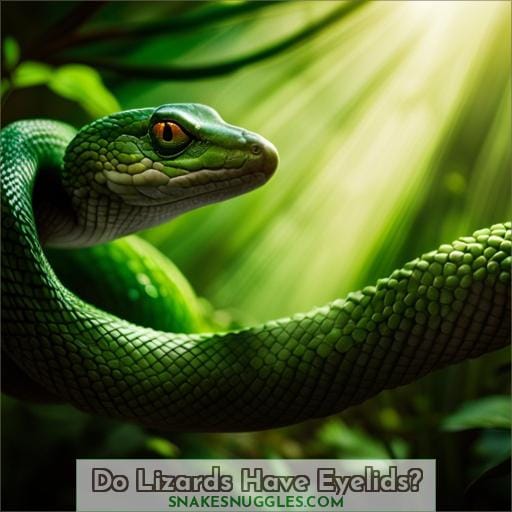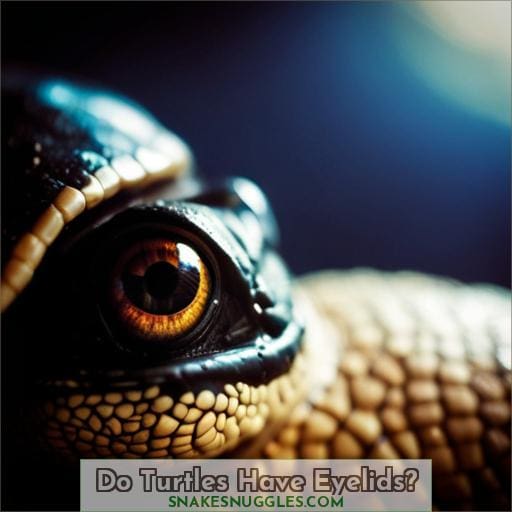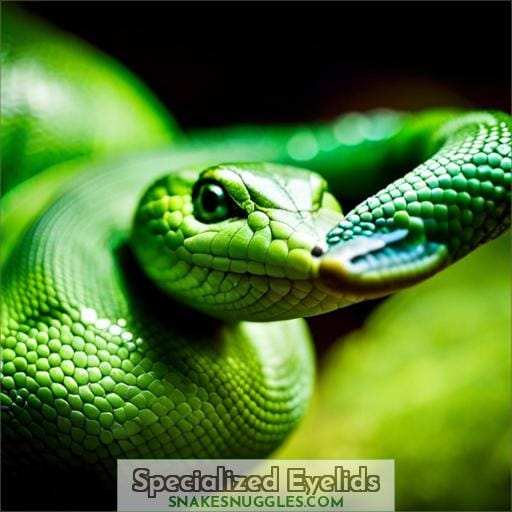This site is supported by our readers. We may earn a commission, at no cost to you, if you purchase through links.
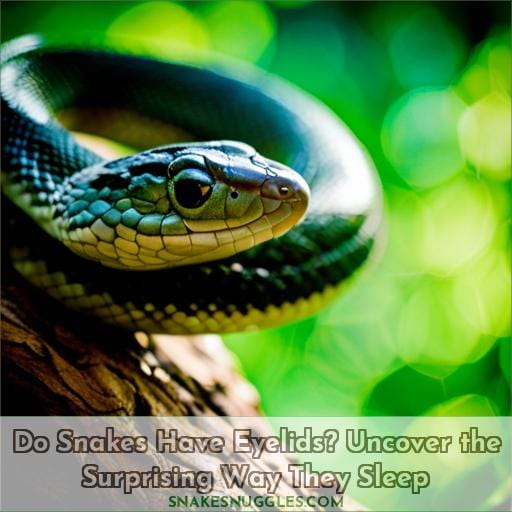 Stranger things have happened than a snake not having eyelids. But that’s the reality – snakes don’t have them, and instead rely on something called a brille to protect their eyes from the elements.
Stranger things have happened than a snake not having eyelids. But that’s the reality – snakes don’t have them, and instead rely on something called a brille to protect their eyes from the elements.
In this article, we’ll uncover why snakes don’t have eyelids and how they manage to sleep without them, as well as exploring what other reptiles do or do not possess these specialized structures.
We also take an in-depth look at unique reptile eye adaptations such as spectacles, parietal eyes, and even eyeless eyes! So if you’re curious about the world of reptiles’ eye anatomy, then buckle up for some surprising facts about how they see without lids!
Table Of Contents
Key Takeaways
- Snakes lack eyelids and instead rely on a protective layer called a brille.
- The brille covers snake eyes, preventing dehydration and damage.
- Lizards and some reptiles also lack eyelids and depend on brilles for protection.
- Turtles use nictitating membranes instead of traditional eyelids.
Why Don’t Snakes Have Eyelids?
You may be wondering why snakes don’t have eyelids like you do, but they actually have adapted a special layer of protection that allows them to stay constantly protected. This transparent brille covers the eye and helps keep it moist while also healing scratches over time.
Since the brille is fixed in place, snakes can’t blink and must sleep with their eyes open – initiated by their brain alone. This adaptation is especially important for ground-dwelling species as dirt or debris can easily get into unprotected eyes without proper protection at all times.
Other reptiles such as lizards and skinks lack eyelids too, instead relying on brilles for 24/7 coverage from harm’s way – whereas boney fish use adipose eyelids and frogs rely on nictitating membranes for similar benefits!
Not only are these adaptations beneficial from an ocular point of view, but snakes also possess inner ear parts which enable them to sense vibrations far outside our hearing range (50-1000 Hertz) as well as infrared sensing via heat pits found in pit vipers & pythons.
It’s no wonder why these creatures play such an integral role not just within ecosystems but also in medical advancements.
What Are Brilles?
You’ll be amazed to discover that snakes possess a transparent layer called a brille covering their eyes for protection.
Brilles are eyecups made of skin with eye scales, ocular scale, and preocular scales surrounding the eyeball. They protect it from dirt and moisture loss while providing clear vision in dim light.
The orbital glands below the eye secrete oils which keep the brille moistened. This helps heal scratches over time.
Unlike other reptiles such as lizards or skinks who have adipose eyelids instead of brilles, snakes cannot blink due to their fixed nature.
Snakes need constant eye protection due to their ground-dwelling nature and tunnelling vision.
Some species even have rudimentary ‘eye spots’ on top of their head acting as an extra line of defense against predators!
How Do Snakes Sleep Without Eyelids?
Since snakes lack traditional eyelids, they have adapted with a transparent layer called a brille to keep their eyes moist and protected while sleeping. Snakes sleep with open eyes and need constant eye protection due to their ground-dwelling nature.
To achieve this, the snake’s brain initiates the process of sleeping without closing its eyelids. Brilles provide 24/7 protection from dirt and debris in the environment, preventing infection or damage that would otherwise occur if left unguarded overnight.
Other reptiles, such as lizards, can also lack eyelid structure, but instead possess brilles similar to those found on snakes, which heal scratches over time too.
Vibrations sensed through special organs enable these animals’ sense of hearing despite not having ears as we know them. Meanwhile, infrared sensing pits assist pit vipers in hunting prey efficiently at night, despite lacking true color vision during darkness hours (seeing mainly blue and green).
Snake behavior is largely defensive, helping maintain balance within ecosystems by controlling populations effectively – even providing life-saving medications made from venom components!
How Do Snakes Eyes Work?
Without traditional eyelids, snakes have adapted with a protective layer called a brille that covers their eyes constantly and gives them a glossy appearance. This specialized adaptation provides 24/7 ocular protection from dirt and debris in the snake’s ground-dwelling environment.
The brille is fixed, so snakes cannot move or blink their eyes like humans can.
A unique eye cap structure allows for limited movement of the snake’s eyes to scan its surroundings without removing it from the surface level environment they inhabit most of the time.
Snakes possess inner ear parts which allow them to sense vibrations beyond what humans are capable of hearing (50 – 1,000 Hertz).
Heat pits on pit vipers and pythons enable infrared sensing while certain species show color vision mainly in blue or green hues; this helps when hunting prey at night as well as navigating obstacles during daytime activity periods.
The reptile also relies heavily on its tongue covered by Jacobson’s organ to detect chemical molecules emitted by other animals for tracking food sources nearby—a crucial ability that ensures the survival rate among predators living underground where sight becomes obsolete due to darkness levels below soil level surfaces.
Do Lizards Have Eyelids?
You may be asking yourself, do lizards have eyelids? In fact, some lizards lack eyelids and instead rely on a transparent protective layer called a brille to protect their eyes.
Which Lizards Lack Eyelids?
Lizards such as skinks and chameleons are just some of the reptiles without eyelids. They’ve adapted to their environment by using a unique eye structure, consisting of parietal eyes which provide protection from debris.
Their lack of an eyelid adaptation is due to their more terrestrial lifestyle compared to snakes that need 24/7 protection from dirt and dust. This also applies to other species like frogs, who use a nictitating membrane, while bony fish utilize adipose eyelids instead.
Reptiles’ sensory abilities range between hearing vibrations in 50-1000 Hertz or infrared sensing with heat pits.
| Eyelid Anatomy | Eye Structure | Adaptation Types |
|---|---|---|
| Adipose | Parietal Eyes | |
| Nictitating Membrane | ||
| Brille | ||
| Sensory Abilities & Behavior Roles | ||
| Reptiles & Lizards | ||
| Snakes |
Which Lizards Have Eyelids?
Discover the fascinating adaptations of lizards that have eyelids, giving them a unique edge in their environments. Although many reptiles lack eyelids and possess brilles instead, certain species bear specialized lids for eye protection.
Lidless amphibians like frogs use nictitating membranes to protect their vision while lid-bearing lizards enjoy enhanced sight capabilities due to the lubricating ability of tears. Reptilian vision is further aided by a transparent third lid, which allows light through but filters out debris and dust particles from entering the eyes during movement or rest cycles.
The presence of these protective eye features makes some lizard species more efficient predators than their brille-wearing counterparts, such as snakes, providing an evolutionary advantage over other reptiles in terms of sight abilities and safety measures against potential attack or harm from outside sources.
Do Alligators and Crocodiles Have Eyelids?
You may have noticed that alligators and crocodiles don’t possess eyelids like humans do, but they too have evolved their own form of eye protection. Unlike snakes or lizards, they sport swollen shut eyes when inactive, which prevents dirt from entering the area around the eye.
However, when active, these reptiles must then use other methods to protect their vision. They rub against nearby objects to help clear away dust particles that could potentially cause impairment. As a result of this adaptation, crocodylians are able to keep up with predators and prey while living in environments where debris can be an issue for vulnerable eyeballs.
Additionally, due to their thick skin, many species also lack nictitating membranes. So it’s important for them to maintain good hygiene practices by cleaning any foreign material off after long periods spent in water or mud holes.
Do Turtles Have Eyelids?
Turtles also lack traditional eyelids and have adapted with a transparent layer to keep their eyes moist and protected. This eye scale is known as the nictitating membrane, which provides protection against dirt, debris, and other environmental hazards.
Turtles rely on this layer for 24/7 protection from their ground-dwelling nature.
As with snakes’ vision anatomy, turtles cannot blink due to the fixed nature of their eye scales; however, they can close them if stimulated or threatened. Furthermore, turtle vision differs slightly from that of humans – they possess ultraviolet sensitivity but are not able to see infrared light like some pit vipers do through heat pits in their head region.
While turtles require constant protection for optimal sensory adaptation given the diverse environment in which reptiles live today, snake brilles provide an ideal solution while allowing them access to necessary visual cues throughout their natural activities such as hunting prey or avoiding predators during daily routines without any loss of motion capability like blinking would cause.
Specialized Eyelids
Snakes have evolved specialized eyelids, rather than the traditional type found in other vertebrates. Unlike mammals and birds, which possess upper and lower lids to protect their eyes, snakes instead have a transparent layer called a brille or spectacle that provides constant protection for their eyeless eyes.
This adaptation is also visible in parietal eyes – small light-sensitive organs located on the top of some species’ heads.
Spectacles
Snakes have adapted to their environment with a transparent layer called a spectacle, providing protection and healing for the eyes. A brille is not an eyelid; it’s more like clear glasses that cover the eye in snakes and other reptiles such as lizards and skinks.
Brilles protect from dirt, debris, and dryness while allowing them to see without blinking or having to close their eyes at night.
Eyelidless vision allows for thermal adaptation. The brille offers permanent protection. Snake vision is limited due to the lack of a blink reflex. Spectacles are shed during the shedding process. Their vibrational hearing is enhanced by inner ear parts, helping detect movements.
In addition, they use tongue-flicking smell receptors through Jacobson’s organ. Snakes exhibit various behaviors, including climbing abilities via belly scales and swimming aptitude unique among geckos.
Eyeless Eyes
Your eyes may have eyelids, but snakes rely on the brille to keep their eyes protected and moist all day long. Snakes lack traditional eyelids; instead, they possess a transparent layer called the brille that serves as protection from dirt and debris.
As eyeless creatures, snakes need constant eye protection due to living close to the ground – something other reptiles like lizards or skinks also share in common! Chameleons use light receptors for shedding purposes, while frogs use nictitating membranes – both adaptations that provide unique benefits for certain species of animals when compared with humans’ traditional method of using an eyelid.
Ultimately, brilles are essential for snake survival since they retain moisture and help heal scratches over time – allowing them excellent vision even without having any kind of actual ‘eyelid’ structure!
Parietal Eyes
You may not be aware, but some reptiles have a third eye located on the top of their heads called a parietal eye. This organ is used to help sense light and dark shifts, aiding in camouflage and predator detection.
The parietal eye has an additional purpose: infrared sensing for heat-seeking prey. It also provides snakes with extra protection from dirt and debris – much like the brille covering regular eyes does – when spectacle shedding occurs every few weeks or months.
Reptiles such as lizards, skinks, and blind skinks possess unique adaptations to their eye structures, which are indicative of how important vision is within this animal group! Parietal eyes provide many benefits ranging from increased safety due to infrared sensory capabilities as well as improved ability for camouflaging purposes through detecting changes in light intensity levels.
These features offer immense advantages when it comes to snake survival in harsh environments filled with potential predators.
Frequently Asked Questions (FAQs)
Do snakes have any other eye protection mechanisms?
Yes, snakes have a transparent layer called a brille which covers their eyes to provide constant protection. Brilles help keep snake eyes moist and heal scratches over time. Other reptiles such as lizards and skinks also lack eyelids and rely on brilles for eye protection.
What is the hearing range for snakes?
Snakes possess an impressive hearing range, spanning from 50 to 1,000 Hertz. Moreover, they sense vibrations with their inner ear parts! These abilities give them the power and mastery to detect sound waves that might otherwise be missed by humans.
How do snakes use their tongue and sense of smell?
Snakes use their tongue and sense of smell to detect prey and predators. They flick their tongues to pick up chemicals in the air, then bring them back into a special organ called Jacobson’s, which helps them identify what they’ve found.
This powerful combination allows snakes to hunt even when there is no light or sound available.
What types of locomotion do snakes use?
Snakes use various types of locomotion, such as lateral undulation, sidewinding, concertina, and rectilinear. They also climb using belly scales, and some are excellent swimmers. Some even have the ability to glide through the air! Be amazed by their remarkable abilities to adapt for survival in different environments.
What role do snakes play in ecosystems?
Snakes play an important role in ecosystems by controlling prey populations, aiding in the balance of nature. They help keep the food chain stable and prevent overpopulation of certain species, which can have detrimental effects on other animals or plants.
Conclusion
It’s a mystery why snakes don’t have eyelids, like most of us humans do. After all, they need to keep their eyes safe from dirt and debris, so why no eyelids? Well, snakes have their own protective layer – the brille.
This unique transparent layer covers the snake’s eye, providing constant protection and keeping their eyes moist and scratch-free.
Without eyelids, snakes have to sleep with their eyes open. This is initiated by their brain, and it’s quite remarkable. Additionally, many lizards and other reptiles lack eyelids and have adapted with brilles instead.
Turtles, alligators, and crocodiles, however, have eyelids, as well as specialized eyelids that protect them in different ways.
So, although the answer to the question, Do snakes have eyelids? is no, they’ve adapted in a way that serves them just as well.

